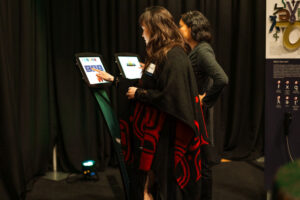by Mary Louise Pratt

Red Bay with islands. Photo: Renato Rosaldo, 2015
I grew up in small-town Ontario, in the part of Canada made famous by writer Alice Munro. From the time I was five years old in the 1950s, I spent every summer of my childhood, and part of nearly every summer after that, on a little bay on the west side of the Bruce Peninsula, facing out on Lake Huron and protected by a string of islands a couple of miles offshore. I live there now for three or four months every year. For as long as I can remember, Red Bay has been a place where I feel deeply at home, a place I think I know very well. The environmental challenge now makes me ask: have sixty years of continuous, though not expert, contact with this geography and ecology given me something to think about, to think with? What do I know about this place to which I’ve been deeply connected for so long? What environmental unfoldings have I witnessed?
Life on the peninsula is a continuous negotiation among life forms: humans, plants, animals, insects, birds, amphibians, all the classes of creatures. In the local paper, rural columnists document the week’s animal, bird, and plant sightings. Shorelines are dominated by summer cottages. There, with humans mainly absent from October till May, other creatures take over. Mice and squirrels move into drawers, ants build empires in wooden walls, mildew blooms in stored linens, mold forms in damp spots, bats wiggle into rooftops, skunks and raccoons snuggle under floors, birds nest in rafters where wasps build paper hives, geese nest on shorelines, and beavers dam up rivers and flood forests.
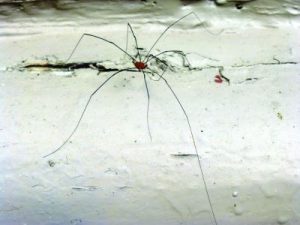
Cabin co-habitant. Photo: Renato Rosaldo, 2015
When summer people arrive, deals are struck. People prevail by day, and animals at night —skunks, raccoons, foxes, bears, deer—all leave their traces and tracks. Garbage bins are (futilely) bear-proofed, pets leashed, vegetable gardens fenced high. Spiders, their eggs and webs are swept from eaves. The carnivorous insects—mosquitoes, black flies, deer flies, horse flies—welcome humans, who smear themselves with repellents and light smelly fuses around their campfires. The un-hated rodents—squirrels, chipmunks, rabbits —appear by day, and humans enjoy their company. The hated rodents—mice, bats —are driven off or killed when they make themselves visible.
Humans busy themselves rearranging the plant world. They mow grasses, plant and weed gardens, cut back brush and branches, rake leaves, spray poison ivy, fell dead trees, stack firewood. The plants command a great deal of the humans’ energies. Several are harvested: morels in spring, other mushrooms in fall; in early summer raspberries, elderberries, blackberries, tiny wild strawberries, swamp leeks; in late summer apples from abandoned orchards.
For as long as I can remember, Red Bay has been a place where I feel deeply at home.
Hunting and fishing are year-round activities, except for breeding seasons. People shoot rabbits, partridge, deer, and the wild turkeys recently reintroduced. Beavers are trapped for bounties and pelts, minnows and dew worms for fish bait. Children endlessly catch frogs and fireflies, then let them go. The best-loved harvest by far, though, has always been fish. All summer long, people of all ages carry rods, bait, tackle, gas tanks, gaffes and hand nets out to twelve- to eighteen-foot aluminum boats with outboard engines, returning hours later with stringers of bass and perch. For many, especially men and boys, life has centered on the contest between fish in the water and humans in boats.

Still life with bear repellent. Photo: Renato Rosaldo and Mary Louise Pratt, 2015
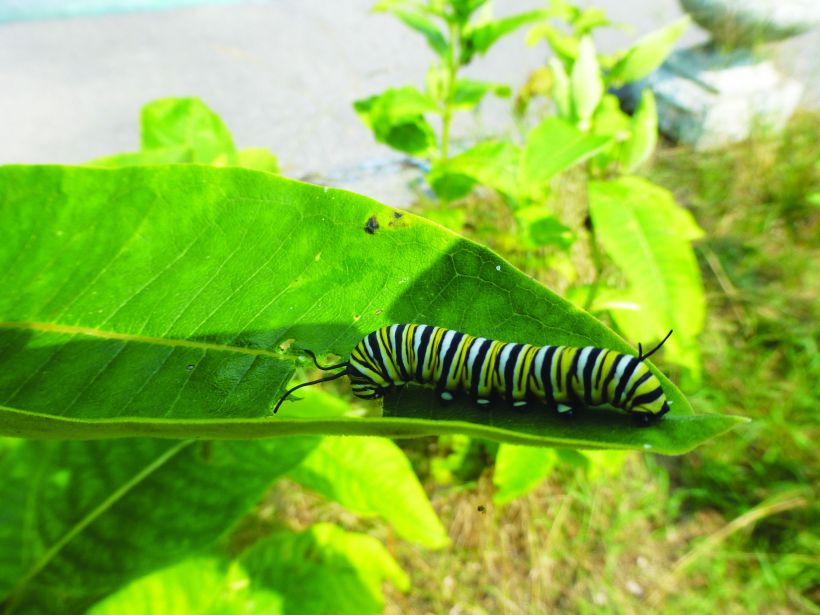
Monarch caterpillar eating milkweed. Photo: Renato Rosaldo, 2015

Mary’s brother’s milkweed patch. Photo: Renato Rosaldo, 2015
Over and over in my lifetime, invading species have complicated this contest, and humans have responded, usually through their institutions. I am struck today by the central role imagination plays in configuring these episodes. Sometime in the late 1950s, the adults around me started talking about fish caught with large, round wounds on their bodies. An alien sea creature, the lamprey eel, had invaded our lakes. The St. Lawrence Seaway, a vast system of locks and canals that enabled oceangoing freighters to move between the Great Lakes and the Atlantic Ocean, had transported this creature to our waters, where it had no natural enemies. A hideous parasite (so we imagined it), it sucked blood and body fluids from other fish, which died or survived in a weakened condition. Lake trout, whitefish, all the commercial fish in Lake Huron, were defenseless against it. Their numbers collapsed, taking down with them the fishing families and the shoreline villages those families sustained—Howdenvale, Pike Bay, Stokes Bay, Lion’s Head, Tobermory. The lamprey was the first plague I remember. For decades now, I discover, it has been contained by an elaborate program combining poisons, pheromones, barriers, and traps, all continuously needed today to keep this beast in check. The program is held up as a model of “a successful aquatic vertebrate pest control program at an ecosystem scale.” The fact that this creature is a beloved delicacy among other peoples is indecipherable from here.
We must have always known that the most transformative invasive species has been ourselves. Ourselves as humans, and as white people.
In the 1980s, the same ocean ships brought the zebra mussel, originally from the Black and Caspian seas. It took a while for them to make their way up to our peninsula. These tiny, wildly prolific aliens live by filtering nutrients out of water, starving the native food chain. They accumulate toxins, leaving water cleaner but poisoning the birds that eat them and fomenting algae. They encrust boats and piers and clog water lines. They suffocate native clams and mussels. Scientists hold them responsible for “the near extinction of many species in the Great Lakes system.” Wildlife agencies are still trying out ways to poison them safely.
In the 1990s, large, black, silent water birds appeared and began taking over nesting islands from the seagulls that had always dominated our airscape and soundscape. “Cormorants,” I was told. A protected species since 1918, nobody seems to know what drove cormorants into the Great Lakes. Here they devour minnows and small fish, and denude islands with their toxic guano. In other places they are considered beautiful. To us, as my neighbor Art puts it, “they are vermin.” Lately, the cormorant invasion has waned somewhat as the humans’ agencies crudely fight back, tearing up nests and pouring oil on eggs.
As we ran wild through our childhood summers in the 1950s, we had no idea that twenty miles away, Ojibway children were still being taken from their families and transported to a residential school hundreds of miles north.
Today up here we live in fear of the Asian carp, known to us from pictures as a large jumping fish that has stormed up the Mississippi from New Orleans and now pounds at the doorways of the Great Lakes. We already despise this creature. Unlike many cultures, we consider carp disgusting, with their round, sucking mouths. We call them garbage fish, and throw them back in repulsion if we catch one. We must count on the Americans to keep this creature in check, but have little confidence they will manage to do it.
I have watched many species wax and wane over these six decades. Around the time the cormorants flocked in, Canada geese also arrived on our beaches, proliferating in huge numbers. Their prodigious droppings are a curse on our (“our”) beachfronts. Beloved loons disappeared for years, then somehow came back. So did frogs. Last summer, kayaking in the early morning, I saw something so strange I doubted my eyes. There, by the shore, scooping up minnows, sat a huge, white swan. Never in sixty years had I seen or heard of a swan on our waters. What shifting habitat had brought it there? As I approached, it took off, wide wings whooshing over my head, making for the islands.
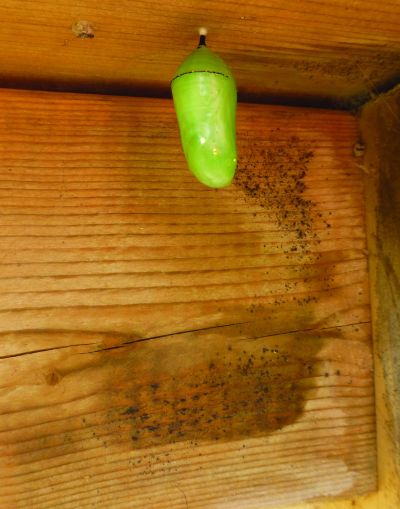
Monarch chrysalis cohabits deck. Photo: Renato Rosaldo, 2015
These days, three impending extinctions worry us: bats, monarch butterflies, and ash trees. Brown bats, key to controlling mosquito populations, have all but disappeared in five short years, thanks to the white-nose fungus first identified in 2006. It looks like they will never come back, an astounding change in our creaturescape. The immense monarch butterfly population has declined to nearly nothing—largely, it appears, due to the disappearance of its lone food plant, the milkweed, along its migration path from Mexico to Canada. People along the route are planting milkweed in hopes of saving the species. Two years ago, only three monarchs nested in my brother’s patch; last year there were seven; this year there are twelve. Ash trees, one of the most common species in our forests, have been stricken by the emerald ash borer, identified in 2002. It came from China in wooden shipping crates and is considered uncontainable. The devastation will be even greater than that wrought by the Dutch elm disease that wiped out one of our best-loved trees in the 1960s and 70s. Ironically, ash trees came into fashion to replace the elms. They are everywhere. Our streets and forests will be cemeteries. In the city of Toronto alone, six hundred thousand doomed trees are already being felled in advance of the plague.
The most talked-about eco-site, however, is the lake itself. The eternal waxing and waning of its shorelines obsesses us. In the 1960s and 70s, the lake receded dramatically, rebounded briefly in the 1980s, then fell back again. Miles of lakefront properties nearly lost sight of water; islands became peninsulas; underwater shoals reared into view; it took a five- or ten-minute walk to get to swimming depth. In 2014 the water came back up a few feet, and in 2015 it has surged back to levels not seen for twenty years. But nobody thinks it will last. It is hard to express the anguish the receding water causes the humans. For most of us, damage to the lake is the worst thing we can imagine. It is the reason most of us are here—it holds us together, provides many livelihoods. We feel certain we are somehow to blame, as humans, but don’t know exactly why. Some insist it’s a natural cycle, but it’s hard to tell whether they believe themselves. Others blame the Americans for taking our water. It’s a bad dream.
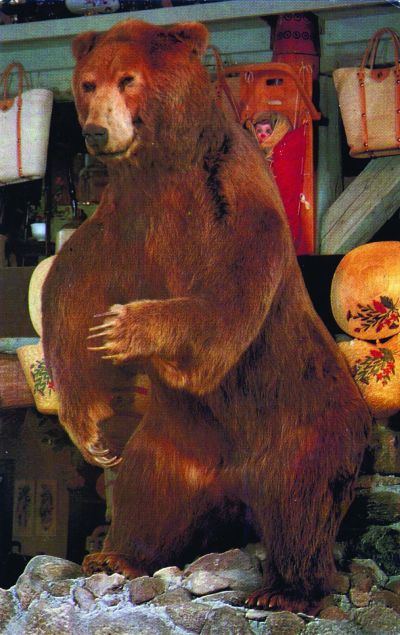
For decades, this stuffed bear has helped market Indian curios at the Handicraft House trading post in Mar, Ontario. Reproduction of a postcard believed to be from the 1960s. Photo: Prismaflex Color, Wilson, Ltd. Dryden, Ont. Retrieved from http://sdlotu.com/2014/07/11/handicraft-house-mar-ontario/
In some way, we must have always known that the most transformative invasive species has been ourselves. Ourselves as humans and as white people. Cottage life was always full of objects evoking what white people thought of as their indigenous predecessors—model birch bark canoes, arrowheads found in sand dunes, songs sung around campfires. Tourist stores sold moccasins and toy tomahawks. We rarely saw the Ojibway people who lived on the nearby reservations, even when we went to their beautiful shorelines to picnic. No one spoke about the treaties and betrayals that had made white peoples’ farms and cottages possible; about how Ojibway men formed the underpaid workforce for the lumber companies that deforested the peninsula with axes and crosscut saws less than a century before; about their migration here in the nineteenth century in flight from Wisconsin. As we ran wild through our childhood summers in the 1950s, we had no idea that twenty miles away, Ojibway children were still being taken from their families, beginning at age four, and transported to a Roman Catholic residential school hundreds of miles north at a place called Spanish River. This had been going on since 1913, and even earlier. Sexual abuse was rife, and students were used in experiments in food deprivation. I had no idea. I don’t know who did.
In 2008, Canada set in motion an Indian Residential Schools Truth and Reconciliation Commission, with a five-year mandate to bring this history into the open and address it. In June 2011, its activities reached our peninsula. A public gathering was held at the reservation. Elders told their stories of this experience, how it had fractured their lives and families, disabled psyches, cost the community its language. I was sixty-two years old hearing this for the first time. As I listened and wept over the course of that unforgettable day, everything I thought I knew and felt about this place cracked open and fell away. For my whole life at Red Bay, a parallel history of invasion and extinction was being lived around me that I had been protected from knowing. That history was not unconnected to me—it was the condition of possibility of my own deeply sustaining experience of belonging and wellbeing, as a blissfully embedded invasive species.
As I listened and wept, everything I thought I knew and felt about this place cracked open and fell away. For my whole life at Red Bay, a parallel history of invasion and extinction was being lived around me that I had been protected from knowing.
Today, difficult negotiations are underway between white residents, many of whom love the place like I do, and First Nations people for whom history must be made right. Joseph Boyden’s earthshaking novel, The Orenda (2013) tells me about the earlier inhabitants, the corn-growing Wendat/Hurons, who in the seventeenth century pacted with the French and were obliterated by disease and by the Haudenosanee/Iroquois, who pacted with the English. How, I wonder, does this all hang together? Will the humans here manage their relations with each other as they try to manage their relations with all the other life forms, old and new, that are doing their thing on the peninsula? “Management” is not how I want to think of it, however. Aren’t we, says the voice of desire, all in this together? Boyden’s wise-woman Gosling tells me no, “Humans are the only ones in this world that need everything within it… But there is nothing in this world that needs us for its survival.”
Yet all us creatures are living change, without clear direction or plot, an unfolding of life and death whose contours will be as concrete as they are unpredictable. It has been many years since I saw one of the huge, iridescent blue moths that used to land from time to time on a lamp-lit window. I don’t know where the hazelnut bushes have gone. Our ash trees are going to die, but perhaps we can fend off the Asian carp for another season. Last year’s swan has not come back, but white egrets have suddenly appeared. Black bears and poison ivy are thriving. Many humans have joined to fight off wind turbines that other humans want to build. A man who was given a boat has been pulling up old hardwood logs from the bottom of a bay where there used to be a sawmill. After eighty years underwater, the wood inside is breathtakingly beautiful—perfect, I’m told, for cellos and violins, though he is making a more saleable item, coffee tables.
.
Back to Vol. 4, Issue 2 | Read the Table of Contents | Like Our Stories? Please Donate!
Mary Louise Pratt is a scholar in the interdisciplinary humanities who has taught at Stanford University and New York University, USA. She works in Latin American studies, language studies, and the study of imperialism. Her best-known book is Imperial Eyes: Travel Writing and Transculturation (Routledge 1992; second edition 2008).
Further Reading
Boyden, J. (2013). The Orenda. Toronto: Penguin.
Kolbert, E. (2014). The Sixth Extinction: An Unnatural History. New York: Holt.
Nadjawon, W. (2014). Neither Wolf nor Dog: An Ojibway Elder’s Tales of Residential School, Wartime Service, First Nation Politics, and Some Experience with the Great Spirit. Tobermory, ON: Tobermory Press.
Truth and Reconciliation Commission of Canada. (2015). Executive Summary. In Honouring the Truth, Reconciling for the Future: Summary of the Final Report of the Truth and Reconciliation Commission of Canada. Retrieved from http://www.trc.ca/websites/trcinstitution/index.php?p=893
York, A. (2010). Fauna. Toronto: Random House.



